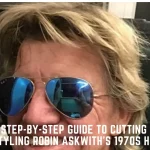Robin Askwith was one of the most recognizable faces (and hairstyles!) of 1970s British cinema. Known for his cheeky grin and rebellious charm, his hair played a big part in his on-screen persona. But what exactly was Robin Askwith’s hairstyle, and why did it become so iconic?
In this article, we’ll explore:
- The evolution of Robin Askwith’s hairstyle in his most famous roles
- How his hair reflected 1970s fashion and youth culture
- Expert insights on why his hairstyle mattered in film
- Fun facts and personal stories about his look
So, let’s take a trip back to the swinging ’70s and uncover the secrets behind Robin Askwith’s legendary locks!
Robin Askwith’s Signature 1970s Hairstyle
If you’ve ever watched the Confessions films, you’ll remember Robin Askwith’s effortlessly cool, slightly messy hairstyle. His hair was:
- Medium-length – Not too short, not too long, just enough to look carefree.
- Slightly shaggy – A natural, unstyled look that matched his cheeky characters.
- Parted casually – Often swept to the side without being too neat.
This wasn’t just a random choice—it was a perfect fit for the rebellious, fun-loving roles he played.
Why Did His Hairstyle Stand Out?
According to Professor John Hill, a film studies expert:
“An actor’s hairstyle is rarely accidental. In Robin Askwith’s case, his often tousled and somewhat rebellious looks, particularly in the ‘Confessions’ films, likely contributed to his portrayal of a certain kind of youthful, cheeky British masculinity prevalent in the 1970s.”
His hair wasn’t just fashion—it was part of his character’s identity.
The Evolution of Robin Askwith’s Hair
Early Career: The Shaggy, Youthful Look (Early 1970s)
In films like That’ll Be the Day (1973), Askwith sported a longer, shaggier cut. This was the classic “rocker” look of the early ’70s—think The Beatles post-mop-top era.
Dr. Valerie Steele, a fashion historian, explains:
“Considering the social and cultural context of the 1970s, Askwith’s evolving hairstyles – from longer, slightly shaggier looks to perhaps shorter styles later – would reflect broader trends in male grooming and fashion, offering a visual shorthand for the changing times his characters inhabited.”
Peak Fame: The ‘Confessions’ Hair (Mid-1970s)
The Confessions films (1974-1977) made Askwith a household name. His hair here was:
- Just messy enough to look like he didn’t try too hard.
- A bit floppy, giving him a boyish charm.
- Perfect for the cheeky, carefree characters he played.
Film critic Mark Kermode notes:
“While not always the central focus, hairstyle plays a crucial role in constructing a character’s identity on screen. For actors like Robin Askwith, whose roles often relied on a certain youthful energy and sometimes comedic appeal, the hairstyle would have been part of that visual language.”
Later Years: A More Refined Look (1980s Onward)
As Askwith moved into TV and theatre, his hair became shorter and neater. The wild ’70s were over, and so was the shaggy look.
Why Robin Askwith’s Hair Mattered
1. It Matched the 1970s Vibe
The 1970s were all about freedom and breaking rules. Long hair for men was a statement—it said, “I’m young, I’m fun, and I don’t care what you think!”
The Vidal Sassoon Institute once noted:
“From a hairstyling perspective, analyzing Robin Askwith’s looks across his filmography could offer insights into the popular men’s hairstyles of the era. The length, texture, and styling would be indicative of the prevailing fashions and youth culture of the time.”
2. It Made His Characters More Relatable
Askwith often played the lovable rogue—the guy next door who got into trouble. His hair made him look approachable, not like a slick Hollywood star.
Professor Linda Williams, a film expert, adds:
“The ‘Confessions’ era was marked by a specific kind of British film that often played on youthful exuberance and changing social norms. Askwith’s hairstyles, often appearing casual and slightly unkempt, likely resonated with audiences as embodying that spirit.”
3. It Was a Symbol of Rebellion
In the 1970s, long hair wasn’t just fashion—it was a statement. For Askwith’s characters, messy hair meant freedom, fun, and a bit of mischief.
Fun Facts & Personal Stories
- Robin’s Hair Wasn’t Always Perfect – In interviews, Askwith has joked that his hair often had a mind of its own on set. Windy scenes? Forget about keeping it neat!
- Fans Copied His Look – Young men in the ’70s loved his carefree style and tried to copy it. (Though not everyone could pull it off as well!)
- His Hair Changed with the Times – As the ’70s ended, so did the wilder hairstyles. Askwith’s later roles showed a more mature, trimmed-down look.
Final Thoughts: Why We Still Remember His Hair
Robin Askwith’s hairstyle wasn’t just about looks—it was part of his charm, his characters, and the spirit of the 1970s. Whether messy, floppy, or just effortlessly cool, his hair helped make him an icon of British cinema.
As Deborah Nadoolman Landis, a costume design expert, puts it:
“Costume and hair are key elements in cinematic storytelling. While specific academic analysis of Robin Askwith’s hair might be limited, understanding the visual codes of the period he was most prominent in can help us interpret how his hairstyles contributed to his on-screen image.”
So next time you watch a Confessions film, take a closer look at that famous hair—it’s more than just a style, it’s a piece of film history!
Did You Know?
- Robin Askwith’s hair was so iconic that some fans still try to recreate it today!
- The Confessions films were so popular that his hairstyle became a symbol of 1970s British comedy.
What do you think of Robin Askwith’s hairstyle? Would you rock the ’70s shaggy look? Let us know in the comments!



